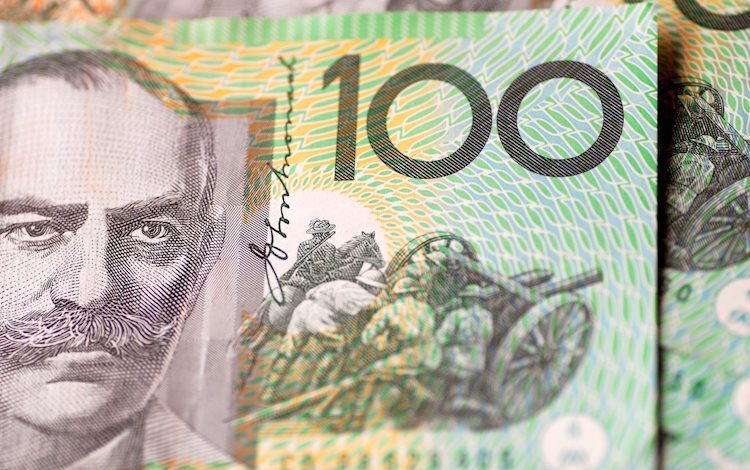Australian Dollar trims gains as US Dollar appreciates due to risk aversion

- The Australian Dollar received support from the hawkish mood surrounding the RBA.
- China’s Consumer Price Index rose by 0.6% YoY in August, up from 0.5% in July but below the market consensus of 0.7%.
- The US Dollar receives support due to rising uncertainty over the likelihood of an aggressive Fed rate cut in September.
The Australian Dollar (AUD) offers its intraday gains against the US Dollar (USD) on Monday. However, the AUD/USD pair received support from the hawkish sentiment surrounding the Reserve Bank of Australia (RBA). The RBA Governor Michele Bullock stated last week that it is too early to consider rate cuts. The board does not anticipate being able to reduce rates in the near term.
The Australian Dollar remains resilient despite the softer inflation data from China released on Monday. China’s Consumer Price Index (CPI) rose by 0.6% year-on-year in August, up from 0.5% in July but below the market consensus of 0.7%. On a monthly basis, CPI inflation increased by 0.4% in August, down from 0.5% in July and worse than the 0.5% estimate. Given the close trade relationship between Australia and China, any changes in the Chinese economy could have a significant impact on Australian markets.
The US Dollar received support as Friday’s US economic data raised uncertainty over the likelihood of an aggressive interest rate cut by the Federal Reserve (Fed) at its September meeting.
According to the CME FedWatch Tool, markets are fully anticipating at least a 25 basis point (bps) rate cut by the Federal Reserve at its September meeting. The likelihood of a 50 bps rate cut has slightly decreased to 29.0%, down from 30.0% a week ago.
Daily Digest Market Movers: Australian Dollar edges higher due to hawkish RBA
- RBC Capital Markets now expects the Reserve Bank of Australia to implement a rate cut at its February 2025 meeting, earlier than its previous forecast of May 2025. Despite inflation in Australia remaining elevated above the RBA’s target, slower economic growth is not considered a sufficient reason for a rate cut this year.
- The US Bureau of Labor Statistics (BLS) reported that Nonfarm Payrolls (NFP) added 142,000 jobs in August, below the forecast of 160,000 but an improvement from July’s downwardly revised figure of 89,000. Meanwhile, the Unemployment Rate fell to 4.2%, as expected, down from 4.3% in the previous month.
- Federal Reserve (Fed) Bank of Chicago President Austan Goolsbee remarked on Friday that Fed officials are starting to align with the broader market’s sentiment that a policy rate adjustment by the US central bank is imminent, according to CNBC. FXStreet’s FedTracker, which uses a custom AI model to evaluate Fed officials’ speeches on a dovish-to-hawkish scale from 0 to 10, rated Goolsbee’s comments as dovish, assigning them a score of 3.2.
- ADP Employment Change showed on Thursday that private-sector employment increased by 99,000 in August, following July’s increase of 111,000 and below the estimate of 145,000. Meanwhile, the weekly US Initial Jobless Claims rose to 227,000 for the week ending August 30, compared to the previous reading of 232,000 and below the initial consensus of 230,000.
- Australia’s trade surplus widened to 6,009 million MoM in July, exceeding the expected 5,150 million and 5,589 million in the previous reading.
- US JOLTS Job Openings dropped to 7.673 million in July, down from 7.910 million in June, marking the lowest level since January 2021 and falling short of market expectations of 8.10 million.
- Bank of America (BoA) has revised its economic growth forecast for China, lowering its 2024 projection to 4.8% from the previous 5.0%. For 2025, the forecast is adjusted to 4.5% growth, while the 2026 outlook remains unchanged at 4.5%.
- Australia’s Gross Domestic Product (GDP) posted a 0.2% reading QoQ for the second quarter, up from the previous quarter’s 0.1% but falling short of the expected 0.3% readings.
Technical Analysis: Australian Dollar remains above 50-day EMA near 0.6700
The Australian Dollar trades around 0.6680 on Monday. On the daily chart, the AUD/USD pair remains below the nine-day Exponential Moving Average (EMA), signaling a short-term bearish trend. Additionally, the 14-day Relative Strength Index (RSI) has dropped below the 50 level, further confirming a bearish momentum.
On the downside, the AUD/USD pair is testing immediate support near the 50-day EMA at the 0.6676 level. A decisive break below this point could strengthen the bearish bias, pushing the pair toward the throwback level around 0.6575 . A deeper decline might target the lower support around 0.6470.
In terms of resistance, the AUD/USD pair may encounter a barrier around the nine-day EMA at 0.6720. A break above this level could pave the way for a potential retest of the seven-month high at 0.6798.
AUD/USD: Daily Chart
Australian Dollar PRICE Today
The table below shows the percentage change of Australian Dollar (AUD) against listed major currencies today. Australian Dollar was the strongest against the Japanese Yen.
| USD | EUR | GBP | JPY | CAD | AUD | NZD | CHF | |
|---|---|---|---|---|---|---|---|---|
| USD | 0.12% | 0.11% | 0.43% | 0.00% | 0.00% | 0.18% | 0.15% | |
| EUR | -0.12% | -0.06% | 0.36% | -0.11% | -0.16% | 0.08% | 0.02% | |
| GBP | -0.11% | 0.06% | 0.28% | -0.05% | -0.10% | 0.11% | 0.07% | |
| JPY | -0.43% | -0.36% | -0.28% | -0.41% | -0.39% | -0.25% | -0.07% | |
| CAD | -0.00% | 0.11% | 0.05% | 0.41% | 0.05% | 0.16% | 0.31% | |
| AUD | -0.01% | 0.16% | 0.10% | 0.39% | -0.05% | 0.21% | 0.15% | |
| NZD | -0.18% | -0.08% | -0.11% | 0.25% | -0.16% | -0.21% | -0.04% | |
| CHF | -0.15% | -0.02% | -0.07% | 0.07% | -0.31% | -0.15% | 0.04% |
The heat map shows percentage changes of major currencies against each other. The base currency is picked from the left column, while the quote currency is picked from the top row. For example, if you pick the Australian Dollar from the left column and move along the horizontal line to the US Dollar, the percentage change displayed in the box will represent AUD (base)/USD (quote).
RBA FAQs
The Reserve Bank of Australia (RBA) sets interest rates and manages monetary policy for Australia. Decisions are made by a board of governors at 11 meetings a year and ad hoc emergency meetings as required. The RBA’s primary mandate is to maintain price stability, which means an inflation rate of 2-3%, but also “..to contribute to the stability of the currency, full employment, and the economic prosperity and welfare of the Australian people.” Its main tool for achieving this is by raising or lowering interest rates. Relatively high interest rates will strengthen the Australian Dollar (AUD) and vice versa. Other RBA tools include quantitative easing and tightening.
While inflation had always traditionally been thought of as a negative factor for currencies since it lowers the value of money in general, the opposite has actually been the case in modern times with the relaxation of cross-border capital controls. Moderately higher inflation now tends to lead central banks to put up their interest rates, which in turn has the effect of attracting more capital inflows from global investors seeking a lucrative place to keep their money. This increases demand for the local currency, which in the case of Australia is the Aussie Dollar.
Macroeconomic data gauges the health of an economy and can have an impact on the value of its currency. Investors prefer to invest their capital in economies that are safe and growing rather than precarious and shrinking. Greater capital inflows increase the aggregate demand and value of the domestic currency. Classic indicators, such as GDP, Manufacturing and Services PMIs, employment, and consumer sentiment surveys can influence AUD. A strong economy may encourage the Reserve Bank of Australia to put up interest rates, also supporting AUD.
Quantitative Easing (QE) is a tool used in extreme situations when lowering interest rates is not enough to restore the flow of credit in the economy. QE is the process by which the Reserve Bank of Australia (RBA) prints Australian Dollars (AUD) for the purpose of buying assets – usually government or corporate bonds – from financial institutions, thereby providing them with much-needed liquidity. QE usually results in a weaker AUD.
Quantitative tightening (QT) is the reverse of QE. It is undertaken after QE when an economic recovery is underway and inflation starts rising. Whilst in QE the Reserve Bank of Australia (RBA) purchases government and corporate bonds from financial institutions to provide them with liquidity, in QT the RBA stops buying more assets, and stops reinvesting the principal maturing on the bonds it already holds. It would be positive (or bullish) for the Australian Dollar.
Information on these pages contains forward-looking statements that involve risks and uncertainties. Markets and instruments profiled on this page are for informational purposes only and should not in any way come across as a recommendation to buy or sell in these assets. You should do your own thorough research before making any investment decisions. FXStreet does not in any way guarantee that this information is free from mistakes, errors, or material misstatements. It also does not guarantee that this information is of a timely nature. Investing in Open Markets involves a great deal of risk, including the loss of all or a portion of your investment, as well as emotional distress. All risks, losses and costs associated with investing, including total loss of principal, are your responsibility. The views and opinions expressed in this article are those of the authors and do not necessarily reflect the official policy or position of FXStreet nor its advertisers. The author will not be held responsible for information that is found at the end of links posted on this page.
If not otherwise explicitly mentioned in the body of the article, at the time of writing, the author has no position in any stock mentioned in this article and no business relationship with any company mentioned. The author has not received compensation for writing this article, other than from FXStreet.
FXStreet and the author do not provide personalized recommendations. The author makes no representations as to the accuracy, completeness, or suitability of this information. FXStreet and the author will not be liable for any errors, omissions or any losses, injuries or damages arising from this information and its display or use. Errors and omissions excepted.
The author and FXStreet are not registered investment advisors and nothing in this article is intended to be investment advice.




